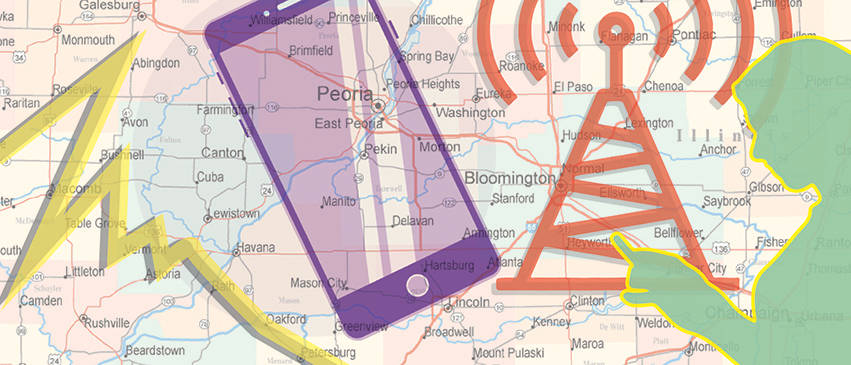Solutions for Rural Broadband

COVID has presented a perfect case for the imperative to bridge the digital divide in our rural communities. From online schooling to remote work and telehealth, the pandemic has shown that broadband is needed not only to thrive, but to survive in the modern world.
On a positive note for central Illinois, the virus has opened our collective eyes to a new dynamic. When people are given a choice of where they want to live—irrespective of where their employer is located—they tend to choose affordable, small and midsized communities with access to outdoor recreation. The future belongs to places that possess these qualities.
However, this future requires the requisite broadband infrastructure to enable full engagement with the global economy. As long as broadband speeds are available, where a person is located makes little difference. One can login to work in San Francisco from 2,000 miles away in Metamora just as quickly as someone in nearby Palo Alto, and the pandemic has greatly accelerated the business acceptance of working from home. How well our midsized and rural communities are connected will help determine whether central Illinois is able to capitalize on these opportunities going forward.
It is unclear exactly how many Americans lack access to high-speed internet. The official FCC estimate is 21 million people. However, due to a flaw in mapping that counts a single connection in a census block as the entire area being served, a recent study funded by Microsoft estimates that figure to be more than 42 million. If you count those with a slow or unreliable internet connection, that number jumps to over 157 million—a little less than half of the country’s population.
Access Around the Region
A deep broadband access and affordability disparity exists within the region. Generally, fixed (wired) connections of more than 25 megabits per second (Mbps) are considered “broadband.” Wireless options such as satellite and cellular networks are available in more areas, but are not considered reliable or cost-effective.
According to FCC data and standards, broadband speeds are available to 99 percent of Peoria County residents, 95 percent of Tazewell County residents, and 93 percent of Woodford County residents. In Mason County, broadband availability lags far behind the Tri-County Area at 67 percent, while Logan County also falls short at 79 percent. And to reiterate, it is quite likely these numbers vastly overestimate access.
In most of the smaller communities throughout our region, internet providers utilize municipal cable connections to create their broadband connections. They usually top out around 100 Mbps due to the constraints of up to 60-year-old copper wiring. For most people, that is enough to work from home during the day, while their children go to school online. The issue many rural residents run into is that just one block outside of their city or village limits, there are no reliable or affordable internet connections available.
Demand vs. Infrastructure
Why is broadband infrastructure lagging behind demand? Quite simply, cost. The Greater Peoria region, like much of America, is dotted with small villages and communities that are not profitable for an ISP to provide service.
As an anecdote: last year I was contacted by a local representative who wanted to assist a constituent who had very limited internet access and was constrained to working from home. I agreed to look into the options and contact a few local ISPs on their behalf. Assuming this person and all nine neighbors in their subdivision agreed to sign up for internet service, here is an example of what a typical rural project might look like:
- 10 total homes
- $50,000 per mile for fiber infrastructure cost
- $600 per home to deliver service from the street to the house
- $32 average monthly cost for the provider to actually deliver the service after installation
If each subscriber pays about $70 per month, net revenue is $38 per home per month. Even assuming an incredibly unlikely one-mile build from an existing fiber network to this subdivision, the total project cost would be $50,000 plus $600 for each home that connected to the service—about $5,600 per customer. If only seven of these homes sign up for service, the cost per home jumps to $8,000. Doing the math, you’ll see that it would take more than 12 years for the provider to break even on their investment. With such a poor return, why would any business make that investment? The answer is that they likely would not, and currently few are.
The Need to Be Ready
The “Connect Illinois” initiative via the Illinois Department of Commerce and Economic Opportunity includes a $420 million effort to help ISPs create a viable business case to connect currently unserved and underserved areas. The first round provided $50 million in state funding to leverage $65 million in non-state matching funds, for a total of over $115 million. More than 26,000 properties were connected for a per-property cost of over $4,420 in all ten economic development regions throughout the state. This program is an example of an imperfect but successful public private partnership, but it is not a panacea. As a region, we need to be prepared for assistance when it becomes available.
The case for rural broadband is immense and well-documented. For businesses and residents, start having conversations with local officials about your experiences with internet service. Contact your local ISP and let them know your community is willing and able to assist them with future projects. If these fiber investments are made correctly the first time, they can last into the next century. If they are made “good enough” for now, they will need to be upgraded again in the not-so-distant future. While it is impossible to predict how the internet will be used in the future, it is clear that fiber internet will be its underpinning. PM
Casey Peterson is director of rural outreach and development at the Greater Peoria Economic Development Council.
- Log in to post comments

